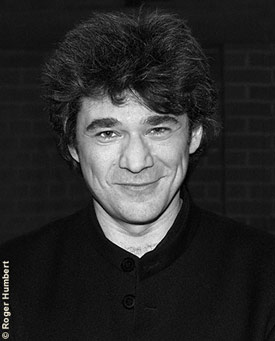The Live Music Report What goes through your mind as you’re selecting a program for the Art of Time Ensemble?
Andrew Burashko First the pieces of music and what they convey come to mind.
I’m always trying to find ways of mixing things up, integrating the music with other elements to create programs that I really want to play and that nobody else is doing.
LMR We rarely hear contemporary work on a classical program. How does it happen that they regularly appear together on your programs?
AB I was a textbook classical soloist. That was my education. I had virtually no exposure to contemporary music. Sixteen years ago, when I was fresh out of school, my first gig was with the new music ensemble, Array Music. I met Roberto Occhipinti there and we became friends. Working with Array was formative, and I worked with other new music groups in town, and found my interest in that field. I also met Rob Piltch about that time and we became best friends, but the only time we played together has been in the Art of Time Ensemble.
LMR What do you want to give your audience by mixing things up — classical music with jazz, light music and serious, dance and film?
AB I’m hoping that the people will be open. I don’t want them to feel like they’re coming to a ‘classical music concert.’ Even if they’ve never heard this music before, I hope there won’t be any prejudice or hang-ups, that they won’t be intimidated by the program.
LMR Shostakovich, and Irwin Schuloff whose music you presented earlier in this season, both have jazz components and historical connections with Jewish suffering.
AB Well, every composer of that generation experimented with jazz. I decided to place Shostakovich’s jazz suite between his two ‘serious’ works on the program. No one in the audience will have heard it, and no one in the audience will imagine that Shostakovich wrote anything that light. Also, it’s an opportunity to involve jazz musicians.
LMR What is significant for you in the fact that Shostakovich composed his Second Piano Trio as a memorial for Ivan Sollertinsky, the musicologist who was a victim of both Nazi and Soviet hatred against Jews?
AB I really do think of Shostakovich as unique, for someone who is not a Jew. I found his respect and the tribute he paid to Judaism was more profound than anybody else’s.
LMR What do you bring to your playing of Shostakovich’s music?
AB First and foremost, I bring myself. I bring my passion, my love and respect for the music. When you hear a musician, you respond to the force of their personality. When we learn to play the instrument, our models are the greatest players in the world. I try to remember that, like them, I do have something to say, and that no one can possibly say it like me.
LMR How do you feel when you play Shostakovich?
AB I feel whatever the music is conveying or triggers in me. In the Trio, there is such a spectrum of emotions, sarcasm, and incredible pain. The slow movement is so incredibly full of compassion.
LMR How do you feel about working with dance and other media?
AB It’s always tricky inviting collaboration from somebody else, but I’ve been lucky so far. I never know how a collaborator will feel or interpret the music. For example, the Piano Trio has a lot of meaning for me. The first time I played it, I was 16. It has so many historic connotations: the Jewish theme, Soviet life, and the circumstances of Shostakovich’s life. Last week I saw what Andrea Nann had choreographed and I was blown away. She really understood and felt the music like I feel it. Nothing in the choreography clashed with the music or communicated something other than the music.
There are also two filmmakers involved. I have a lot of faith that it will be compelling.
LMR What should the audience listen for?
AB The most important thing is for the people to relax, to open themselves up and receive it as music. Not as Shostakovich’s music, this serious, austere, 20th Century Russian classical music, but as amazing music.


